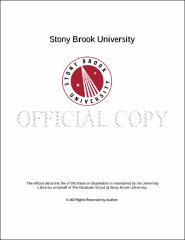| dc.identifier.uri | http://hdl.handle.net/11401/75988 | |
| dc.description.sponsorship | This work is sponsored by the Stony Brook University Graduate School in compliance with the requirements for completion of degree. | en_US |
| dc.format | Monograph | |
| dc.format.medium | Electronic Resource | en_US |
| dc.language.iso | en_US | |
| dc.publisher | The Graduate School, Stony Brook University: Stony Brook, NY. | |
| dc.type | Thesis | |
| dcterms.abstract | The presence of oyster reefs augments the biomass and abundance of many transient fish and crustacean species. Therefore, restoration of oyster reefs has become an increasingly common practice in coastal areas with the goal of enhancing production of transient fish. However, predicting the effect of oyster restoration on transient fish community biomass remains elusive. To address this challenge, I created a trophic bioenergetic model to understand how energy transfers in an oyster reef and assess the effects of various restoration strategies on transient fish species. The model used a set of functional groups representing organisms commonly found in an oyster reef and a set of ordinary differential equations describing the growth of these functional groups. The constructed model was evaluated using empirical data from a restoration project in the northern Gulf of Mexico. Three different scenarios were used to simulate restoration strategies relating to (1) oyster growth rate, (2) oyster carrying capacity, and (3) dependence of transient fish on oyster reef derived prey. Model simulations revealed that enhancing the oyster growth rate both reduced the amount of time for the oyster reef community to stabilize and produced biomass increases for the transient fish community. Additionally, the biomass of transient fish was higher when consumption from an outside source, representing an adjacent habitat, was maintained than when the majority of the transient fish consumption was derived from the oyster reef. These findings highlight the need for restoration strategies that focus on favorable conditions for oyster growth and maintain connectivity among estuarine habitats. As the number of projects and monetary effort for oyster restoration continues to increase, models could be used as tools to understand the possible effects of restoration projects on transient fish communities and set goals for restoration projects. | |
| dcterms.available | 2017-09-18T23:49:44Z | |
| dcterms.contributor | Peterson, Bradley J | en_US |
| dcterms.contributor | Nye, Janet | en_US |
| dcterms.contributor | Borrett, Stuart. | en_US |
| dcterms.creator | Gomez, Elizabeth | |
| dcterms.dateAccepted | 2017-09-18T23:49:44Z | |
| dcterms.dateSubmitted | 2017-09-18T23:49:44Z | |
| dcterms.description | Department of Marine and Atmospheric Science. | en_US |
| dcterms.extent | 84 pg. | en_US |
| dcterms.format | Monograph | |
| dcterms.format | Application/PDF | en_US |
| dcterms.identifier | http://hdl.handle.net/11401/75988 | |
| dcterms.issued | 2015-12-01 | |
| dcterms.language | en_US | |
| dcterms.provenance | Made available in DSpace on 2017-09-18T23:49:44Z (GMT). No. of bitstreams: 1
Gomez_grad.sunysb_0771M_12514.pdf: 6415697 bytes, checksum: c8fffc5b44bc3880ac51609495ef86da (MD5)
Previous issue date: 1 | en |
| dcterms.publisher | The Graduate School, Stony Brook University: Stony Brook, NY. | |
| dcterms.subject | Ecology | |
| dcterms.subject | Crassostrea, Ecology, Model, Oyster, Restoration, virginica | |
| dcterms.title | A dynamic oyster reef bioenergetics model: predictions of secondary production based on different restoration scenarios | |
| dcterms.type | Thesis | |

